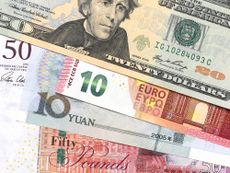DoorDash won't deliver for investors. Here's how to short it
American food-delivery app DoorDash can’t even make money in a pandemic. Matthew Partridge explains the best way to short it.


Last year was a good one for the US stockmarket: the benchmark S&P 500 index shrugged off the effects of Covid-19 and finished the year up by 16%. Technology stocks did even better thanks to constant money printing by the Federal Reserve; interest from first-time investors using “free” trading apps, such as Robinhood; and a belief that the pandemic would result in major economic changes.
One tech stock that has done very well from this boom is the food-delivery app DoorDash (NYSE: DASH). It nearly doubled on its first day of trading in early December, rising to $190 from its initial price of $102. Even today it is trading at $156, a jump of 50%, giving the group a value of nearly $50bn.
However, as I’ve pointed out in the past, initial public offerings that soar on their first few days have a habit of doing very badly subsequently, and DoorDash is unlikely to prove an exception to the rule. Perhaps the biggest problem is that food delivery is an extremely competitive market with a huge array of firms all vying for the same customers. While DoorDash is currently the largest food-delivery company in the US, with just under 30% of the market, it faces stiff competition in the form of Uber Eats and Grubhub.
Subscribe to MoneyWeek
Subscribe to MoneyWeek today and get your first six magazine issues absolutely FREE

Sign up to Money Morning
Don't miss the latest investment and personal finances news, market analysis, plus money-saving tips with our free twice-daily newsletter
Don't miss the latest investment and personal finances news, market analysis, plus money-saving tips with our free twice-daily newsletter
There already signs that delivery apps are starting to engage in a price war in order to win market share. For example, last month Grubhub announced that it was abolishing customers’ fees. At the same time, restaurants are lobbying cities around the US to impose limits on the amount of money that delivery firms can charge them.
This has resulted in New York City temporarily capping restaurant fees at 20% until social-distancing restrictions on capacity are removed. California has also recently imposed rules that permanently prevent delivery apps offering delivery from a restaurant unless the owner has given explicit permission for it to do so. Many platforms have been listing restaurants they don’t have permission to deliver from to make their network appear more comprehensive than it is.
Running out of time
While the lockdown has given sales a massive boost, DoorDash still hasn’t been able to find a way to turn a consistent profit. This doesn’t bode well for what will happen when restrictions are lifted for good in a few months’ time and people ditch takeaways for in-person dining.
Despite this, DoorDash trades at 24 times 2020 sales, compared with only 16 times sales for Just Eat Takeaway (which owns Grubhub) and seven times for Uber. Domino’s Pizza, which has managed to make a lot of money from home delivery, trades on a price-to-sales ratio of just three. With DoorDash down by over 10% from its recent peak, there’s a good chance that the market is starting to sour on it. Seize the opportunity to short it at the current price of $173 at £16 per $1. Because of the volatility inherent in tech stocks, I suggest you cover your position at $233, which should give you a maximum downside of £960.
Trading techniques... five resolutions for 2021
In the last trading column, I talked about five lessons I’d learned from 2020. Here are some resolutions for 2021.
1. Produce more short ideas
Markets are at record highs, with prominent short-sellers wondering if short-selling has a future. As a contrarian, I think this suggests that the market is due a fall. While I have tried to maintain a balanced portfolio, I do tend to have slightly more longs than shorts.
2. Ensure that short tips have cooled off before tipping them
Seemingly overpriced shares can become even more expensive. It therefore makes sense to wait until they are at least 20% down from their 52-week high, or trading below their 50-day moving average, before betting that they will fall.
3. Make sure that long tips have positive momentum
Bargain hunting can be a winning strategy, but shares that have fallen can fall further before bottoming out. It is logical to wait until a share is either 20% above its 52-week low, or at least above its 50-day moving average.
4. Wait at least six months before revisiting a tip
As I noted at the end of last year, I got burned several times when I tried to revisit a company I had previously tipped (most notably in the case of International Consolidated Airlines Group). While there may be times when it is worth revisiting a tip, a six-month cooling-off period sounds sensible.
5. Settle on slightly looser stop-losses.
At present my typical initial stop-loss is equal to 25% lower than the initial price (for long tips), or 25% higher (for short tips). I’m going to increase this to 33% so that I get stopped out of positions less frequently.
How my tips have fared
My long tips have fared well in the last few weeks, with four of them rising. Media group ITV climbed to 110p, builder Bellway to 2,970p, transport company National Express to 258p and pub group Mitchells & Butlers to 238p.
The only exception was Norwegian Cruise Lines, which has fallen to $24.14. Overall, all five long positions are making money. They are earning a total of £4,936, up from £3,825 at the end of last year.
My short tips, however, have been a mixed bag, with three of them going in my favour but two of them rising. Online insurer eHealth slipped to $70.36 and online furniture retailer Wayfair fell too; it is now trading at $259. Social network Twitter is down to $48.
However, electric-truck company Nikola rose to $17.08, while online retailer Ocado is up to 2,478p. Overall, eHealth, Nikola and Wayfair continue to make money for this column, while Twitter and Ocado are losing it. My short tips are making net profits of £2,060, up slightly from £1,896 at the end of the year.
I have three positions that are older than six months (ITV, eHealth and Nikola), and they are all making money, so I won’t suggest that you close them.
This means that I have six short tips and five long tips, which is a good balance. However, I recommend that you increase the stop-losses on both National Express and Mitchells & Butler to 190p (from 180p) and Bellway to 2,750p (2,725p). I would also reduce the price at which you cover the eHealth short to $100 (from $110).
Matthew graduated from the University of Durham in 2004; he then gained an MSc, followed by a PhD at the London School of Economics.
He has previously written for a wide range of publications, including the Guardian and the Economist, and also helped to run a newsletter on terrorism. He has spent time at Lehman Brothers, Citigroup and the consultancy Lombard Street Research.
Matthew is the author of Superinvestors: Lessons from the greatest investors in history, published by Harriman House, which has been translated into several languages. His second book, Investing Explained: The Accessible Guide to Building an Investment Portfolio, is published by Kogan Page.
As senior writer, he writes the shares and politics & economics pages, as well as weekly Blowing It and Great Frauds in History columns He also writes a fortnightly reviews page and trading tips, as well as regular cover stories and multi-page investment focus features.
Follow Matthew on Twitter: @DrMatthewPartri
-
 Adidas, Nike or Jordans - could collectable trainers make you rich?
Adidas, Nike or Jordans - could collectable trainers make you rich?The right pair of trainers can fetch six figures. Here's how you can start collecting vintage Adidas, Nike or Jordans now
By Chris Carter Published
-
 Early bird ISA investors flock to global funds, India and the US
Early bird ISA investors flock to global funds, India and the USThere’s been an increase in investors maxing out their ISA at the start of the new tax year. But where are they putting their cash and why does it make sense to be an early bird investor?
By Vaishali Varu Published
-
 It's time to back the yen, says Dominic Frisby
It's time to back the yen, says Dominic FrisbyThe Japanese yen has been weak for a long time, says Dominic Frisby. That may soon change.
By Dominic Frisby Published
-
 What is FX trading?
What is FX trading?Tutorials What is FX trading and can you make money from it? Rupert Hargreaves explains how it works and the risks.
By Rupert Hargreaves Last updated
-
 The Burberry share price looks like a good bet
The Burberry share price looks like a good betTips The Burberry share price could be on the verge of a major upswing as the firm’s profits return to growth.
By Dr Matthew Partridge Published
-
 Why you should short this satellite broadband company
Why you should short this satellite broadband companyTips With an ill-considered business plan, satellite broadband company AST SpaceMobile is doomed to failure, says Matthew Partridge. Here's how to short the stock.
By Dr Matthew Partridge Published
-
 It’s time to sell this stock
It’s time to sell this stockTips Digital Realty’s data-storage business model is moribund, consumed by the rise of cloud computing. Here's how you could short the shares, says Matthew Partridge.
By Dr Matthew Partridge Published
-
 Netflix has plenty of life in it yet – here's how to trade the shares
Netflix has plenty of life in it yet – here's how to trade the sharesTips Netflix still has plenty of scope for growth, says Matthew Partridge, and the shares are reasonably priced. Here's how to play the Netflix share price.
By Dr Matthew Partridge Published
-
 Trading: Dunelm will keep growing, here's how to play it
Trading: Dunelm will keep growing, here's how to play itTips Furniture retailer Dunelm surged during the pandemic, but its shares have since fallen back. But it is well placed to take more market share from rivals, says Matthew Partridge. Here, he explains how to play the Dunelm share price.
By Dr Matthew Partridge Published
-
 Ashtead – a building equipment rental firm on solid foundations
Ashtead – a building equipment rental firm on solid foundationsTips The prospects for Ashtead, the building-equipment rental firm, are auspicious. Matthew Partridge explains the best way to play the share price.
By Dr Matthew Partridge Published